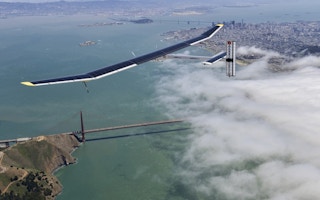A record-breaking attempt to fly around the world in a solar-powered plane is set to get under way on Monday.
The aircraft - called Solar Impulse-2 - will take off from Abu Dhabi and head east, first to Oman, and then to India.
Over the next five months, it will skip from continent to continent, crossing both the Pacific and Atlantic oceans in the process.
Swiss adventurers Bertrand Piccard and Andre Borschberg will share the pilot duties in the single-seater vehicle.
They will stop off at various locations to rest and to carry out maintenance, and also to spread a campaigning message about clean technologies.
Borschberg will start the journey with a takeoff from the Emirate’s international airport at about 06:30 local time (02:30 GMT).
“I am confident we have a very special aeroplane, and it will have to be to get us across the big oceans,” the Solar Impulse CEO told BBC News.
“We may have to fly for five days and five nights to do that, and it will be a challenge.
“But we have the next two months, as we fly the legs to China, to train and prepare ourselves.”
“
I had this dream 16 years ago of flying around the world without fuel, just on solar power. Now, we’re about to do it. The passion is there and I look forward so much to being in the cockpit.
Swiss pilot Bertrand Piccard
The project has already set a number of world records for solar-powered flight, including making a high-profile transit of the US in 2013.
But the round-the-world venture is altogether more dramatic and daunting, and has required the construction of an even bigger plane than the prototype, Solar Impulse-1.
This new model has a wingspan of 72m, which is wider than a 747 jumbo jet. And yet, it weighs only 2.3 tonnes.
Its light weight will be critical to its success.
So, too, will the performance of the 17,000 solar cells that line the top of the wings, and the energy-dense lithium-ion batteries it will use to sustain night-time flying.
Operating through darkness will be particularly important when the men have to cross the Pacific and the Atlantic.
The slow speed of their prop-driven plane means these legs will take several days and nights of non-stop flying to complete.
Piccard and Borschberg - whoever is at the controls - will have to stay alert for nearly all of the time they are airborne.
They will be permitted only catnaps of up to 20 mins - in the same way a single-handed, round-the-world yachtsman would catch small periods of sleep.
They will also have to endure the physical discomfort of being confined in a cockpit that measures just 3.8 cubic metres in volume - not a lot bigger than a public telephone box.
Flight simulators have helped the pilots to prepare, and each man has developed his own regimen to cope.
Borschberg will use yoga to try to stay fresh. Piccard is using self-hypnosis techniques.
“But my passion also will keep me going,” said Piccard.
“I had this dream 16 years ago of flying around the world without fuel, just on solar power. Now, we’re about to do it. The passion is there and I look forward so much to being in the cockpit.”
The support team is well drilled. While the mission will be run out of a control room in Monaco, a group of engineers will follow the plane around the globe. They have a mobile hangar to house the plane when it is not in the air.
It is not at all certain Solar Impulse will succeed. Computer modelling suggests the ocean crossings are feasible, given the right weather conditions.
But that same modelling has shown also that there may be occasions when the team simply has to sit tight on the ground for weeks before a fair window opens.
“Last year, we had a very good exercise. We went around the world virtually, but with actual conditions,” explained Raymond Clerc, mission director.
“For the Pacific crossing, it was an easy decision. We had a very good window on 2 May. But when we were on the East Coast of the USA, we had to look to cross the Atlantic and we had to wait 30 days to find a good window to cross the Atlantic. And then it was easy - 3.5 days and we were in Seville, [Spain],” he told BBC News.
If the pilots should come unstuck over the Pacific or the Atlantic, they will bail out and use ocean survival gear until they can be picked up by a ship.
Of the two protagonists, Andre Borschberg perhaps needs a little more introduction.
A trained engineer and former air-force pilot, he has built a career as an entrepreneur in internet technologies.
Bertrand Piccard, on the other hand, is well known for his ballooning exploits.
Along with Brian Jones, he completed the first non-stop, circumnavigation of the world in 1999, using the Breitling Orbiter 3 balloon. The Piccard name is synonymous with pushing boundaries.
Bertrand’s father, Jacques Piccard, was the first to reach the deepest place in the ocean (a feat achieved with Don Walsh in the Trieste bathyscaphe in 1960). And his grandfather, Auguste Piccard, was the first person to take a balloon into the stratosphere, in 1931.










